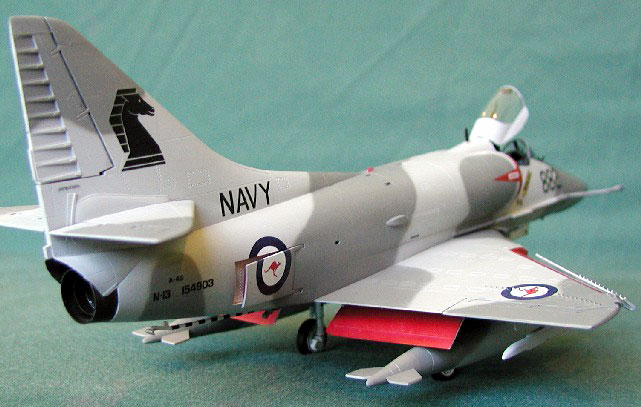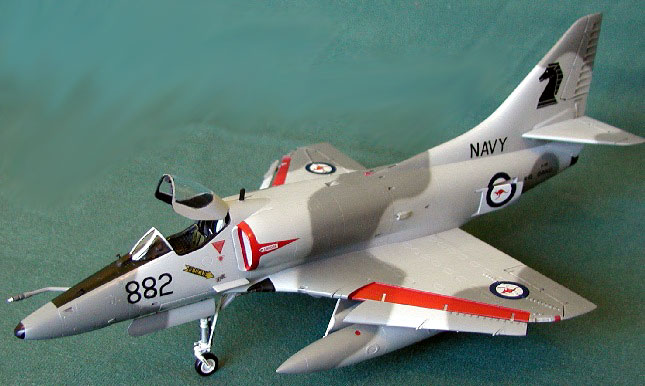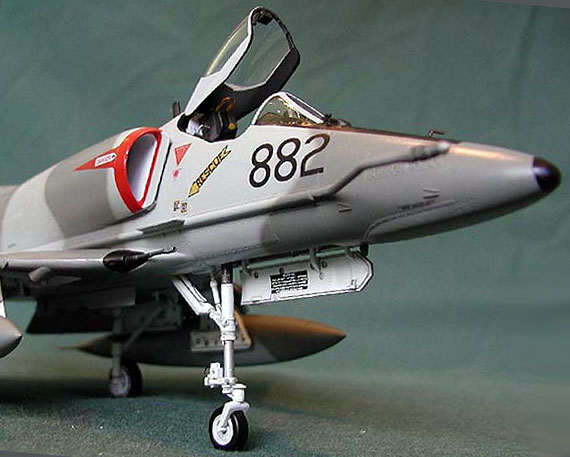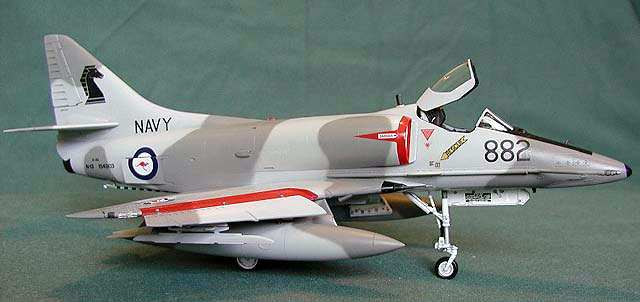|
Douglas A-4G
Skyhawk
by
J.D. King
|

|
|
Douglas A-4G Skyhawk |

Hasegawa's 1/48
scale A-4E/F Skyhawk is
available online from
Squadron.com
ROYAL AUSTRALIAN NAVY A4-G
In 1965 the decision was made to replace the De
Haviland Sea Venoms and Fairy Gannets used by the Fleet Air Arm of the
Royal Australian Navy (RAN). The aircraft chosen were the Douglas A4
Skyhawk and Grumman S2 Tracker. Initially an order for 8 single seat and
2 trainers, listed as A-4E‘s, was made. In 1970 a second order of
similar size and composition was made, but the aircraft were listed as
A-4F.
In RAN service the aircraft were designated A-4G and were modified to
suit Australian requirements. Based upon the USN A-4F the G retained the
strike capability of 250/500 lb bombs and 2.75 or 5in rockets plus other
maritime strike stores, but it was also intended for fleet defence
duties. The result was the aircraft’s ability to be fitted with a pair
of AIM-9B missiles. The avionics were also updated and consequently the
USN dorsal ‘hump’ was not required. Other external differences included
a lack of the numerous electronic sensors seen on the chin, behind the
nose gear and above the jet pipe. The G also lacked the chaff and flare
dispensers found around the arrester hook on late F’s and M’s.

Whilst in Australian service the Skyhawk retained their USN serial
numbers but a RAN prefix of N13 was added. A three digit call or buzz
number was also given and painted upon the nose. All 20 aircraft were
delivered in USN gloss light gull grey and white. This scheme was
retained until 1979 when replaced by the two-tone scheme of aircraft
grey and light admiralty grey.
The Skyhawk’s were formed into two squadrons, VF-805 operating from HMAS
Melbourne and VC-724 the Operational Flying Training School operating
from Nowra on the New South Wales south coast. In 17 years of service
between 1967 and 1984, 10 Skyhawks were lost. Six to crashes as a result
of aircraft or crew failure and five to either catapult/arrester
failure, or loss from the flight deck.
The Skyhawks RAN career ended in the mid 1980’s when a replacement for
the aging HMAS Melbourne was sought. The British Harrier equipped HMS
Invincible was at the time up for sale and considered, but the 1982
Falklands war intervened to show the RN how valuable her carriers were
and she was withdrawn from sale. The older HMS Hermies was offered
instead, but the decision was deferred. A month later a General Election
was held in Australia that resulted in a change of government. The day
after the result the new administration announced that a replacement
carrier would not be sought ending RAN fixed wing aviation. The last
Skyhawk sortie was flown on 30 June 1984. The surviving 10 Skyhawks were
not completely lost, as they were sold to the Royal New Zealand Air
Force in the same year.
Hasegawa's 1/48
Scale A-4E/F Skyhawk
|
Like many before me I can only say good things
about Hasegawa’s 48 A-4 offering. Moulded in plastic that is easy to
work with, covered in finely engraved panel lines and more than
sufficient detail. After opening the box and seeing the detail I decided
that for a change no after market goodies would be used, the kit cost
also helped make this decision. All that would be used would be a decal
sheet from Hawkeye models.
The raised cockpit detail was sufficiently accurate for my taste and was
very easily picked out with some dry brushing. Some additional scratch
built plumbing was added to the tub mostly upon the rear bulkhead along
with some items on the sidewalls and panel sill. To the seat I added
some PE seat belts from the spares box and some plumbing found in my
reference photos.

Moving to the intakes I found the only area I was not quite happy with.
I found that the three-piece intakes went together well and with some
careful clean up all the seams could be removed. But dry fitting before
assembly found the problem, I had a seamless intake but the join between
the internal ducting and the intake was plainly obvious. In the end I
carefully and painstakingly added fine grade milliput (white) with a
toothpick through the intake after assembly. This was then smoothed with
a cotton bud and water to produce an acceptable, but not what I would
call ‘good’ finish.
The remainder went together very well with the only filler required was
to remove panel lines not seen on RAN aircraft around the arrester hook.
All unfiled weapons stations (left outboard and centre) were drilled and
carved to show the openings visible when without ordinance. Plumbing was
added to all undercarriage legs and doors. The raised panel lines on the
external fuel tanks were removed and rescribed and an AIM-9 mount
(included in the kit) added to right outboard. (no missile at time of
writing and photographs).
My model is finished as N-13 154903 (882) of VF-805
operating off HMAS Melbourne in 1982. Having built a number of 1/72
Skyhawks in the two tone scheme before, I departed from what many would
call convention. My references state the colours are Aircraft Grey BS
381C-693 / FS16187 and Light Admiralty Grey BS 381C-697 / FS15414 but
though these are probably very correct they just don’t look right.

On a small scale they seem to produce a very blue
appearance. But from my memory from airshows, private photos and
references this blue appearance is not present when viewed full size. So
through test painting an old kit with just about every grey I had, a
combination that looked right was found, yep no FS, no BS no RLM, it
just looked right. Light Admiralty was replaced with Aeromaster Warbirds
Light Ghost Grey and Aircraft Grey with Humbrol 140 Dark Gull Grey and
sealed with Tamiya clear. All intake warning red and anti glare panel
black was masked and painted rather than applied using decals.
Decals were from the Hawkeye RAN A4 sheet. I am not
100% sure but I think the sheet is printed using an ALPS pronter (I’ve
never used these before so I could be wrong).
I found that any dark coloured decals (buzz
numbers, checkmates emblem and serials) were fine but anything requiring
white was not. A small white backing decal sheet is provided but when
two decals are combined they become excessively thick. As a result I did
not use the sheets roundels or intake warnings. Decals from the kit or
Aussie Decals were used instead. If I was to use the sheet again I would
mask out the required areas during finishing and spray the required
white. Another problem encountered was the carrier film. It is a single
piece across the sheet which is no great challenge, but it is very thick
and it seemed that no amount of setting solution would get it into panel
lines.
Hasegawa’s 1/48 A4 is an excellent kit. It beats
the old Monogram A4 hands down in all but one area, price. It goes
together very well, sits right, looks right and can be finished as a
very effective display piece. Hawkeye models decal sheet has some minor
failings but it gives you the opportunity to build every A4 the RAN ever
had and up to six aircraft from the one sheet! If you are like me and
prefer to build kits with blue and white roundels or Red/Black kangaroos
rather than stars and bars or black crosses this kit and sheet is for
you.
-
Aungst D.W, Douglas A-4E
Skyhawk, Hypescale
http://www.kitparade.com/features00/a4skyhawkda_1.htm
-
Campbell G. A4 walk
around photographs, Aircraft Resource Centre,
www.aircraftresourcecenter.com
-
Gallemi F, A4 walk around
photographs, Aircraft Resource Centre
-
Stohr S.R. A4 walk around
photographs, Aircraft Resource Centre
-
Wilson S, 1993, Phantom,
Hornet and Skyhawk in Australian Service
Click on the thumbnails
below to view larger images:
Model, Images and Text Copyright © 2002 by
J.D. King
Page Created 19 May, 2002
Last Updated 04 June, 2007
Back to HyperScale
Main Page
Back to
Features Index
|
Home
| What's New |
Features |
Gallery |
Reviews |
Reference |
Forum |
Search